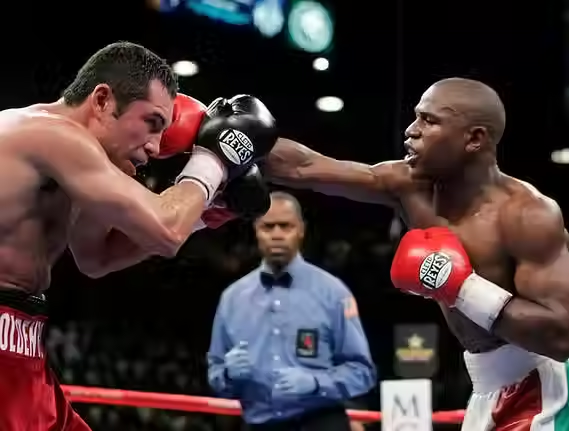BoxingAcademyOnline.com
TYPE OF BOXING
JAB
The video demonstrates the movement JAB as follows.

1- Correct Stance:
- Stand straight with your feet shoulder-width apart.
- If you're using your right hand (i.e., your left foot is forward), your body should be slightly turned to the side.
- Keep your knees slightly bent, not locked.
2- Hand Position:
- Place your hands at face level, with your fists lightly clenched.
- The lead hand (the one closest to your opponent) should be ready to throw the jab.
3- Executing the Jab:
- Quickly extend your lead arm toward your opponent.
- At the moment of execution, keep your fist tight and avoid overextending your arm.
- While throwing the jab, don't forget to use your body weight slightly to enhance power.
4- Quick Recoil:
- After executing the jab, quickly return your hand to a defensive position, ready to move or throw another attack.

CROSS
1. Correct Stance:
- Just like the jab, you should start by positioning your feet correctly.
If you are using your right hand (with your left foot forward), make sure your feet are in a good position to support your balance.
- Keep your knees slightly bent, not locked. This allows you to move easily.
2. Hand Position:
- The lead hand (left hand if you are using your right hand) should be in a defensive position in front of your face.
- The rear hand (right hand if you are using your right hand) should be near your chin or cheek, but ready to move at any moment.
3. Executing the Cross:
- Start by moving your rear hand (the strong hand) directly toward your opponent.
- As you extend your arm, use your body weight fully, especially by rotating your torso and hips (this motion helps add power to the punch).
- Make sure your hand isn’t moving straight only, but there should be body rotation to make the punch more powerful.
- Your fist should land directly on your opponent’s face or body without stopping.
4. Focus on Speed:
- The punch should not only focus on power but also on being fast and precise. The goal is to surprise your opponent with the speed of your movement.
5. Quick Recoil:
- After executing the cross, you should quickly return your hand to a defensive position (as it was before the attack) to protect your face and be ready for another attack or defense.
HOOK
1. Correct Stance:
-
As with other punches, your feet should be in the right position to support your balance.
-
Slightly bend your knees, and maintain a stable body position with your hands in a defensive stance.
2. Hand Position:
-
The lead hand (left hand if you're using your right hand) should be in a defensive position in front of your face.
-
The rear hand (right hand if you're using your right hand) starts near your chin or cheek but should be ready to move.
3. Executing the Hook:
-
Arm Positioning: When throwing the hook, bend your arm at about a 90-degree angle, keeping your fist close to your face or body.
-
Side Movement: As you throw the punch, rotate your torso and hips sideways to add power. Don't just rely on your arm; use your whole body.
-
The Punch Itself: Instead of a straight punch, move your hand in a curved motion toward the target, almost like closing a circle. The goal is to hit your opponent from the side of their head or body.
-
Make sure your fist is clenched tightly throughout the punch.
4. Using Hips and Torso:
-
When throwing the hook, you should rotate your hips and torso together. This movement will add more power to your punch.
5. Quick Recoil:
-
After executing the hook, quickly return your hand to a defensive position to protect yourself. Always be ready for a counter-attack from your opponent.
.jpg)

UPPERCUT
1. Correct Stance:
- Make sure you are in a prepared and defensive position. Your feet should be shoulder- width apart, and your knees should be slightly bent to provide balance and easy movement.
- Your body should be in an upright position, while staying alert when attacking so you can also defend at the same time.
2. Hand Position:
- The lead hand (left hand if you're using your right hand) should be in a defensive position in front of your face.
- The rear hand (right hand if you're using your right hand) should be beside your chin or cheek but ready to move quickly.
3. Executing the Punch:
- Hand Movement: Start by directing your rear hand (right hand if you're using your right hand) in an upward motion toward the opponent's chin or jaw. Your hand should be slightly angled inward, not straight.
- Using the Torso: The punch should not only come from the arm, but you should also use your whole body. Bend your rear knee and raise your torso slightly while executing the punch. The movement of your hips and torso will help generate power.
- Fist: Make sure your fist is tightly closed during the punch to ensure maximum impact.
4. Timing and Control:
- Timing is crucial in the uppercut. This punch is typically used when your opponent is close to you, either at a short distance or when they are attacking.
- Make sure your hand moves quickly and correctly toward the target. The goal is to reach the opponent's chin or jaw area to destabilize them.
5. Quick Recoil:
- After executing the uppercut, you should quickly return your hand to a defensive position (just as it was before the attack).
- Do not leave your hand hanging in the air after the punch, as this exposes you to a counterattack.



